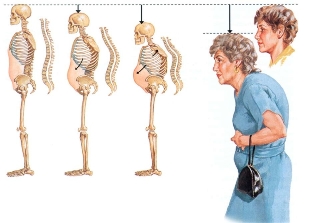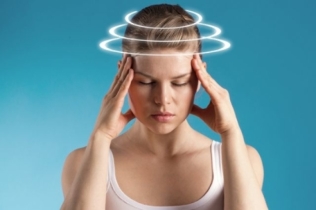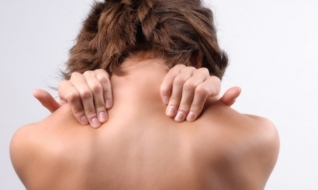Cervical osteochondrosis – a disease of the spine, which causes degenerative changes in the intervertebral discs. In the first stage the symptoms are almost undetectable, but the spread of the pathological process, the patient's condition deteriorates.

The causes of the disease
Osteochondrosis arises as a result of the uneven load on the spine. Predisposing factors:
- heavy physical exertion;
- wearing the wrong shoes;
- malnutrition;
- problem exchange processes;
- nervous and mental exhaustion.
The disease can occur during carrying a child. A big risk of multiple pregnancies. The pathological process may be genetically determined.
Stage and photos
The development of osteoarthritis is slow. There are 4 stages of the disease:
- In the first step. Patients feel some discomfort after long walks and stay in the same position. Began to form seals on the spinal discs.
- In the second stage. Pain occur. The doctor prescribes manual therapy and pain relievers.
- The third step. There is marked degenerative changes in the intervertebral discs.
- In the fourth stage. The final stage of the disease, which affects almost all parts of the spine.

The last stage of the conservative treatment is ineffective. The doctor will prescribe surgery, which does not require a long recovery.
Common symptoms
Lower back pain may cover one or more of the spine. Most often affects the cervical vertebrae. Clinical symptoms, such as deviations, which are directly related to the work of the brain. Consider all the main symptoms of this disease.
Pain in the neck, neck and neck area
Patients often have neck pain, the neck and the neck area. This is due to insufficient blood supply to the brain. Deformation of the vertebrae leading to compression of the vertebral artery. Against the background of these degenerative processes can occur hernia.
Along with pain, there is a risk of serious complications. For example, disruption of the blood stress or permanent hearing and vision. Sometimes patients with panic attacks and anxiety. They can last from 30 minutes. A condition called diencephalic syndrome.
Another cause of pain is spasm of the muscles, which leads to a reduction in blood flow. Patients can temporarily lose the ability to move his neck. The strong strain leads to the fact that pain in the neck begins to flow to the head and can continue to spread head. In these processes, the patient suffers from severe migraines.
Noise, the ears, the feeling of stuffiness in the ears

This complex of symptoms is called the inner ear or cochlea. Doctors are not always able to incorporate such deviations in the development of cervical degenerative disc disease.
Noise and ringing in the ears happens when you change the position or long-term stay in one position.
Dizziness
The cervical vertebrae are quite thin, so the preservation of the head they have to endure heavy loads. They are more susceptible to deformation than the thoracic spine. As a result the deviation occurs dizziness, which can be:
- System. Is the feeling of a circular motion of the body and the surrounding objects. It occurs due to malfunction of the vestibular apparatus, muscles and receptors in the joints.
- No system. The patient presents a feeling of faintness, upset and uncertain status in a vertical position. Mind circular rotation is missing.
If you experience such symptoms, you should immediately consult a doctor. The causes for emergency hospitalization of the patient:
- numbness in the shoulder;
- paralysis of the facial muscles;
- loss of consciousness;
- severe headache.
Displaced vertebrae and muscle spasm lead to pinched nerves, which nourish the brain. Due to lack of oxygen have dizzy spells. Initially, the lack of oxygen occurs in the back of the head, because it is in the middle of the vestibular apparatus.
The lack of air
The lack of air osteochondrosis can be of several types: problems with breathing and lack of oxygen. Breathing the background of the pinched nerves that send signals from the pharynx into the esophagus.
The lack of air happens because of the compression of the nerve. The result is a spasm of the diaphragm, which can lead to changes in the depth and rhythm of breathing. The patient becomes stuffy and difficult to breathe.

This is a serious symptom, such as shortness of osteochondrosis dangerous the development of some other complications. In this case, the doctor prescribes medication.
Nausea
The cervix is the most sensitive, because its structure has a large number of nerve fibers and blood vessels. Passes the carotid artery, which carries oxygen and nutrients to the brain. With cervical osteochondrosis formed bulge, and herniated discs.
The rear structures of the brain receives insufficient amount of blood. This triggers compensatory reactions. Narrowing of the arteries leads to increased blood pressure. The patient's feeling of nausea.
If you don't restore blood flow to the hind-brain structures, the patient develops vomiting and loss of consciousness. Long stroke increases the risk of stroke and further disability.
Problems with vision
Osteochondrosis of the neck the patient may experience double vision, floaters and flashing. They show the onset of serious diseases that appear on the background of osteochondrosis. These include the following diseases:
- glaucoma;
- cataract;
- disease Claude Bernard-Horner.
It is very important to monitor the changing state of the eye. This is an important symptom that indicates a health problem.
Jumps in blood pressure
At first it may seem that the jumps in blood pressure and lower back pain have nothing in common. However, it is not. Degenerative changes in the spine suffers from the autonomic nervous system.
Jumps are observed during the day. This disease is characterized by long-term hypertension.

The Hopping dynamics of the daily uretralnoe hypertension occurs when the reflex irritation of the nervous terminations and momentary spasms krovenosnyh vessels.
Symptoms of high blood pressure, cervical osteochondrosis:
- severe headache;
- pressure after the peak stress or muscle strain;
- pain in the limbs: hands, feet, etc.;
- the low sensitivity in the neck area.
Sudden fainting, or fainting
Sudden fainting can occur as a result of a brief cessation of blood flow in the vertebral arteries. If the patient lost consciousness, it must be applied so that the feet were above his head. It activates the blood flow to the brain. After fainting, you may experience problems with speech and movements.
Throat problems
Sometimes the occurrence of degenerative processes of the cervical vertebrae, can testify only of the throat symptoms. They manifest themselves through:
- difficulty swallowing;
- sore throat;
- foreign body sensation in the throat;
- itching.
Such features relate to damage to nerve and vascular trunks, which pass through the spinal cord. However, these symptoms are detected not only in osteochondrosis, but also inflammation and swelling.
Rise in body temperature
With cervical osteochondrosis increased body temperature. This problem occurs when the following damage:
- vertebral artery syndrome;
- disc bulge;
- stenosis of the spinal canal.
Fever can cause neurosis, neurological zabolevaniem and fibromyalgics syndrome. Sometimes there are several pathological conditions that aggravate the symptoms of degenerative disc disease.
Symptoms depend on the stage of the disease

- In the first development stage of the symptoms of the disease may not be detected. The first signs of the beginning of the degenerative process are: headache, slight limitation of physical activity neck, headache, upset stomach, neck and arms. These characters stressed, when turning or tilting the head.
- In the second stage of development began in the protrusion of spinal discs, brain crevices start to taper off. The pain becomes more severe, is tinnitus, and sleep disorders.
- The third stage is characterized by the destruction of the fibrous ring of the disc. There are dislocation and displacement of the vertebrae, herniation of the cervical spine.
- In the fourth stage, the most degenerative changes are irreversible.
Who was born in the brain?
Symptoms in the brain can be strong or minor. Brain abnormalities only occur if a strong compression of the vertebral artery bony outgrowths. As a result, there is a problem with the use of blood to the head, the brain, and this provokes spasms of the small blood vessels and the hypothalamus regulate the disorder.
With cervical osteochondrosis can cause the following symptoms:
- The hypothalamus. It may be neurological and physical.
- Syncope and drop-syndrome. They show that the patient feels weakness in the legs and lose consciousness for a few minutes.
- Vestibular-arm. Observed dizziness head turns.
As a result of these degenerative processes, patient try to avoid public places. I saw him having unreasonable fears and depression.
Differences between women and men
Symptoms of cervical chondrosis men and women are virtually indistinguishable. Degenerative changes of the cervical spine vertebrae are more common in women, this is due to the anatomical structure of the cervix. In men, the cervical musculature is better developed.

Chondrosis of the spine in children and adolescents
Chondrosis of the spine in children and adolescents is Usually due to the delay of the development of the connective tissue. It can be the result of genetic abnormalities or disorders of mineral metabolism. The immature intervertebral discs vulnerable to different pathological processes.
The disease is caused by lack of exercise, long sitting at the computer and the availability of excess weight. The symptoms of this disease are similar to symptoms of osteoarthritis in adults. Loss of the cervix the patient experiences pain in the neck, dizzy spells and migraines.
Diagnosis
Before diagnosis and treatment, the doctor will perform several diagnostic tests. Is an external review, assess posture and study the muscles.
Computed tomography of the
Computed tomography allows you to see the bone in 3D-projection. According to the principle perform this procedure similar to an x-ray. However, as the diagnostic allows you to see the layered image.
This procedure is not available for children and pregnant women, because of the high dose x-ray irradiation. Among the contraindications include lack of patient's ability to remain in place for several minutes.
X-ray
X-rays – a classic procedure that is specified in the diagnosis of degenerative disc disease. It is practically harmless and it can be used to assess the extent of degenerative changes. With this technique it is possible to identify the disease at an early stage.

X-ray does not allow to obtain cross-sectional images of the affected tissues. There are a number of more modern and informative methods of examination. X-ray is only suitable for the initial diagnosis.
Osteochondrosis is a dangerous condition that without timely treatment can lead to irreversible degenerative changes and disability. In the early stages can be just a mild discomfort. With the development of the pathological process, the symptoms intensifies. When the first signs of lesions of the spine should immediately contact your doctor.
































